Steph W. from SEOPressor


...help you check your website and tell you exactly how to rank higher?


98
score %
SEO Score

Found us from search engine?
We rank high, you can too.
SEOPressor helps you to optimize your on-page SEO for higher & improved search ranking.
By allysa on August 2, 2016

Last month, we’ve covered the fundamental of content marketing for newcomers in our post “How To Produce Effective Content For Your Website“, which went over different aspects of content marketing and offered suggestions for those who just started to get into it. Since many of you asked for more, we’re revisiting the topic today.
After all, SEO and content marketing are constantly evolving. There’s always more to talk about. You can also read my other blog post about SEO copywriting on how to write for both robots and readers.
There were a few more key points that we wanted to get into in the previous blog post, but didn’t have room. So now, we’re back with more hints and tips for creating effective content. In this blog post, we’ll be covering more technical and “behind-the-scenes” issues such as usage of tags in code and creating content marketing calendars.
Then, we’ll wrap it up by looking towards the future and commenting on a few trends that might not be big right now, but are likely to grow in popularity over the next year.
So, let’s get started with one of the big audience-related issues we didn’t have room for in the previous post:
In the previous blog post, we talked a lot about how content needs to be intensely focused on your human audience, and that remains true.
However, there’s another side of content marketing because there’s a completely different audience which also needs to be served – robots.
Computer automation is a big part of online life, and it’s a key component in how search engines work. Sites like Google and Bing deploy networks of automated bits of code called “web crawlers” whose job is to roam around the Internet, following links and indexing the pages they come across.
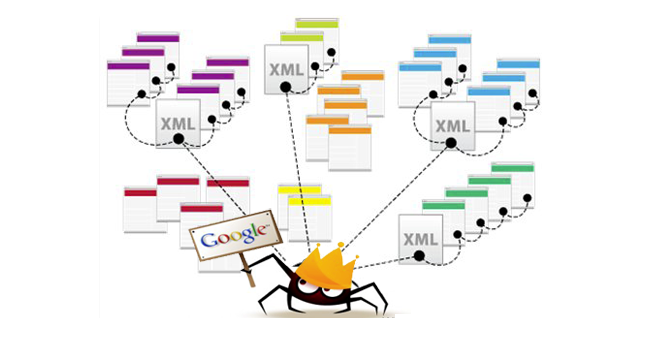
They generally examine the code of the web page itself, pulling information out of that to build the indexes which search engines rely on.
Therefore, part of creating good SEO content involves inserting information into your HTML and other web code, specifically so the web crawlers can see it and index it.
Most decent webpage-creation suites today have tools that allow you to insert tags into your documents, so there’s little or no direct coding involved. If you need a reference on the code itself, the W3 group has a good list of standardized HTML tags.
For SEO content optimization, these are the tags generally considered to be the most important:
Title:

In many cases, a search engine will pull its listing for your content directly from the Title tag. It will also run some keyword checks to make sure that title matches the content. So make sure that your targeted keywords are relevant.
Header:
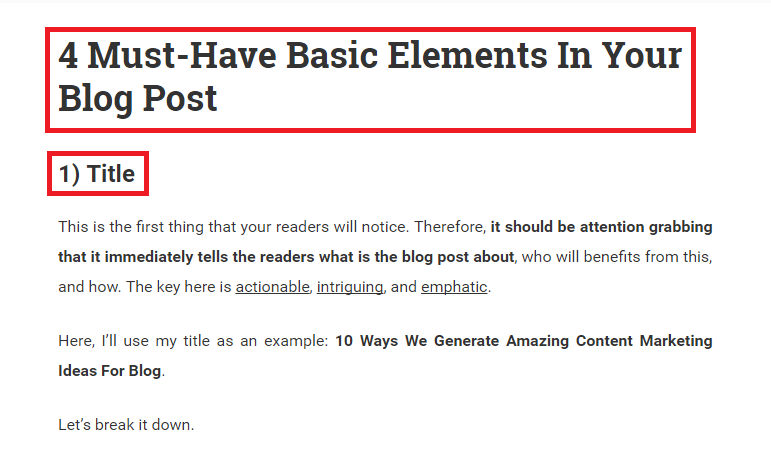
Header tags are used to create headings and subheadings, with a hierarchy going from H1 (biggest) to H6. Web crawlers use the header tags to figure out the most important pieces of content on a page, so tag appropriately.
Keyword:
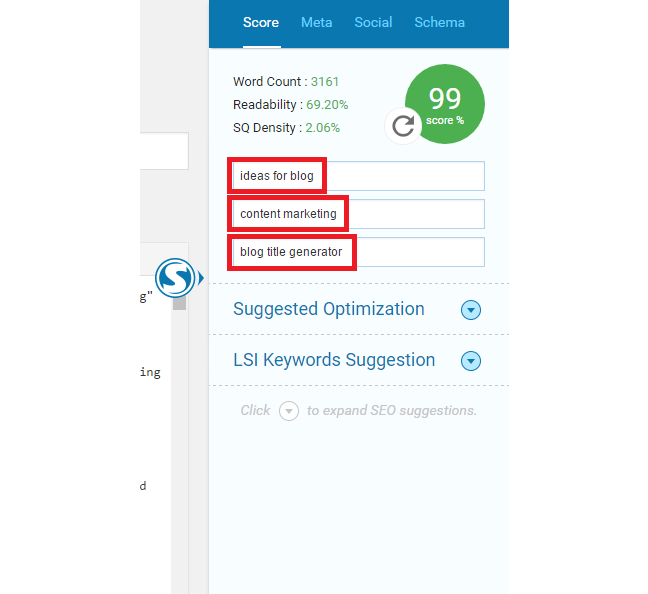
As I mentioned before, keywords are the basic of SEO. It’s very important to have keywords in your content as they help with indexing. Again, be sure they’re relevant to your content.
Content-Specific Tags:
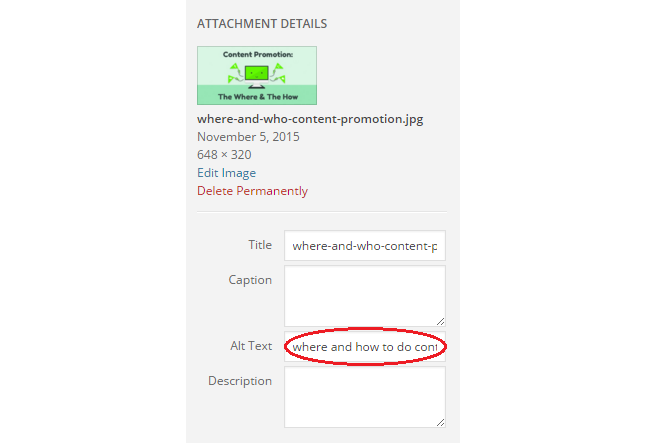
Always be sure to tag all media files such as graphics, videos, and sound files with proper titles and keywords in the ALT text. This is what gives them priority in media-specific searches, such as Google Image Search.
And a final note on the topic of tagging: If you’re ambitious, you can look into the Open Graph Protocols. These are somewhat complicated to deploy, and not widely adopted yet.
However, when used correctly, they allow a page to use rich content that spans multiple media, such as webpages whose functionality carries over when posted to Facebook. Their usage is likely to grow in years to come as media becomes increasingly mixed.
Now, let’s talk about humans – your humans, to be exact.
When someone just begins content marketing, it’s fine if they’re basically doing it ad-hoc. They think of a blog topic, write it, and post it on their website within a day or two. However, at some point in this process, you’re going to want to start thinking ahead, or planning for bigger events.
That’s when you need a content marketing calendar.
Simply put, it’s a calendar where you schedule your planned blogs ahead of time, and virtually any calendar-style app can be used. The future time span covered is up to you, although it’s generally in the area of 1-3 months.
This accomplishes several major goals:
As your blog expands, you’ll probably have more than one person writing it. The calendar can include the assigned authors and ensure there’s always someone responsible for each piece of content. If a substitution needs to happen, it’s documented.
Just like how we do it on SEOPressor.
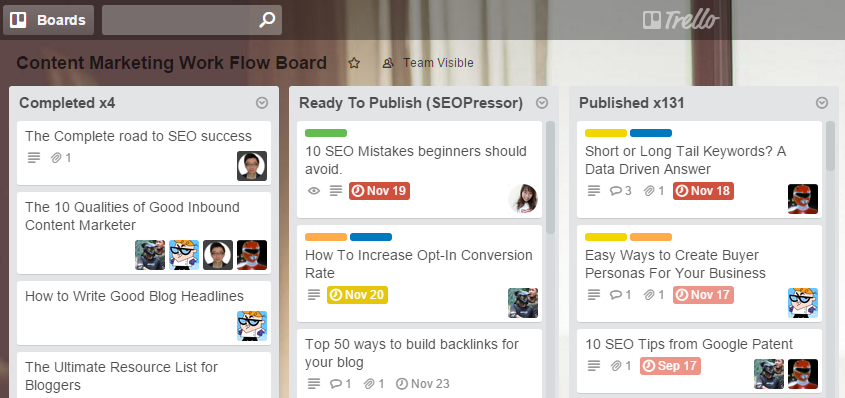
This is how we keep up with our schedule in SEOPressor.
With this, it gives you a visual overview of your content so you can be more certain you aren’t repeating yourself or covering the same topic too often.
Likewise, you can also plan for more and different types of media for further variety. As we discussed in the previous blog, a variety of content types is always a good idea.
Other than that, you can start planning themed days. One might set up the calendar to have short, fun pieces on Monday, longer in-depth pieces on Wednesday, and something deeper or thought-provoking on Friday. This adds more structure to your blog, and lets you begin “programming” it in the same sense as TV programming.
You can also plan for cross-promotions. Do you have a new product launch coming up in October? Start planning NOW for the content which will accompany it, so everything is lined up and ready for the media blitz.
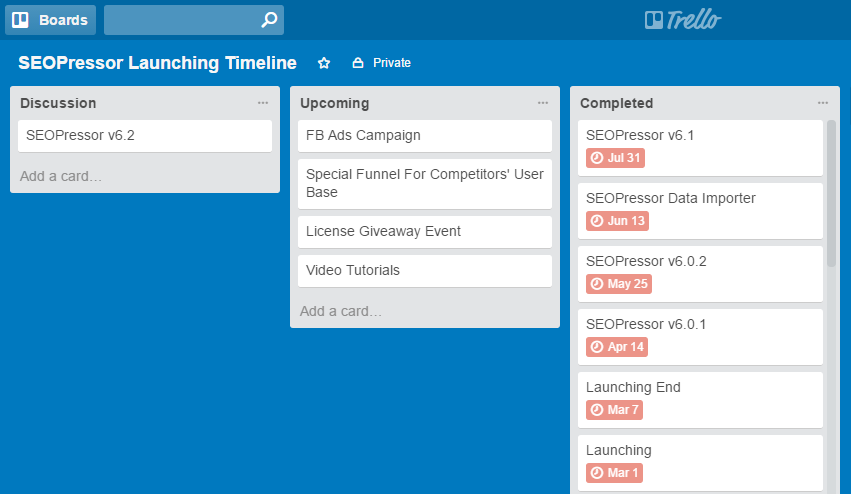
This is how we planned our strategy for the launching of SEOPressor Connect on Trello.
Social media can be factored in. You can pre-plan your Tweets, Facebook, or LinkedIn posts, and other social media to dovetail with your blog or product promotions.
Of course, when working with a content marketing calendar, it’s important to remain flexible. Leave some room for breaking news commentary, industry shifts, and other in-the-moment topics which can’t be predicted ahead of time.
And like all other aspects of content marketing, track your results and alter your strategies based on reader response.
A content calendar can also start to be the basis of automation systems.
“Content marketing automation” is one of those buzzwords that covers a lot of ground. Broadly speaking, it can cover ANY system used to remove manual work in creating and posting content. Even something as simple as Hootsuite’s scheduled Tweets falls under the banner.
On the high end – and we’re talking very expensive custom software suites here – content marketing automation can create vast databases of content, cross-linked and indexed, which allows content to be easily reused in a variety of media.
For example, the system could be set up to drip-feed emails to interested leads on a periodic basis, with those emails largely pulled from a database of blog articles which have been tagged according to topic and interest. Tied into a robust Customer Relationship Management system tracking leads and their interests, almost every step of this can be automated.
Marketing automation is definitely the future of SEO content distribution, but beyond relatively simple tools, it’s probably still too expensive for most SMBs to get into at the moment. However, it’s worth keeping an eye on.
And speaking of which…
Let’s have a little fun.
One of the great things about technology trends is that we have a pretty clear roadmap of new inventions which are either brand-new or likely to be introduced very soon. You might not want to embrace any of these immediately, but on the other hand, strategically jumping in early might give you a leg up.

According to MidiaResearch, they believe that vertical video will rule on smartphone.
Honestly, we’re not fans either. However, there are a lot of smartphone users out there who refuse to flip over their phones and want video formatted to be tall rather than wide. You might experiment with vertical video formats and see what kind of response you get. But I bet you’ve never heard of a Snapchat user complaining about the vertical viewing experience, right?
For all the big names you know like Facebook and Reddit, there are dozens of niche competitors trying to get a toehold. Many of these appeal to very specific markets. As an example:

Imzy wants to be a friendlier version of Reddit.
Look for niche sites, and see if there’s one which fits your demographic. If you’re an early adopter, you’d be the big fish in a small pond and potentially with a highly responsive audience.
Remember how we said above that robots are getting smarter? Virtual assistants like Siri and Cortana are becoming more widely used and increasingly competent.
https://youtu.be/V5h0gVcsQ-g
As customers begin simply asking “Siri, what’s the nearest grocery store?” and accepting whatever she says, online marketers who can find ways to get priority among the VAs will see a lot of benefits. We’re not far from “Virtual Assistant Optimization” being a thing. As a matter of fact, chatbot and AI is already part of an important future for customer service.
2016 is the year that Virtual Reality hit the mainstream, but it’s probably going to be another year or two before it sees widespread adoption. However, content types such as 360-degree movies are already being produced.
If you have a very cutting-edge tech-savvy audience, VR support may already be worth consideration.
In short, SEO content marketing is a huge field and there’s always more you can do to expand your efforts. Keep an eye on the horizon, and always be willing to experiment with new ideas which might put you in front of new audiences. You can also check your SEO score on Website SEO Checker.

Website SEO Checker calculates your website’s SEO score for free.
Are there any other effective ways that you’ve used to optimize your content for both robots and readers? Do let us know in the comment down below if we left anything out.
Related Posts:
Updated: 4 January 2026


Save thousands of dollars (it’s 100x cheaper)

Zero risk of Google penalty (it’s Google-approved)

Boost your rankings (proven by case studies)
Rank High With This Link Strategy
Precise, Simplified, Fast Internal Linking.
